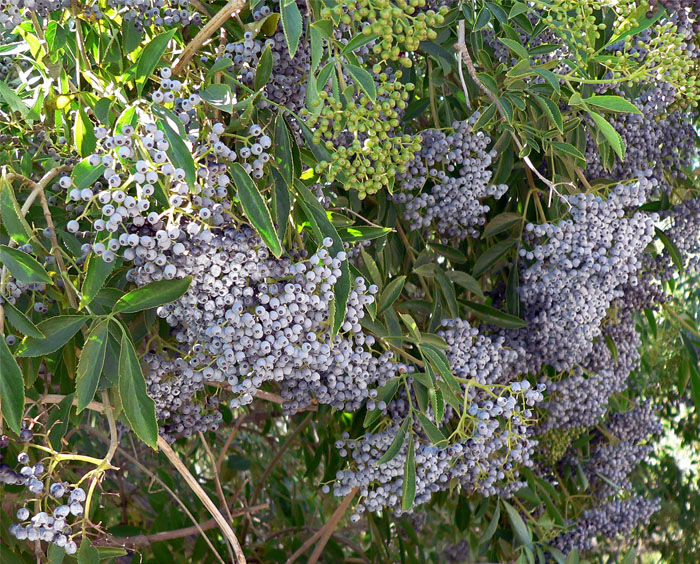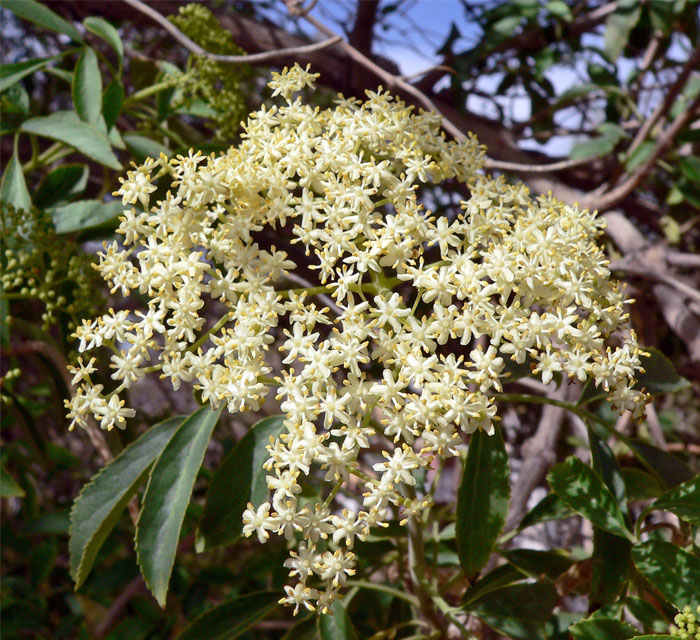Western Blue ElderberrySambucus caeruleaHeight: 20' average mature height Hardiness Zones: 5-8 Find my zone Aspect: half shade to full sun
Size Availability
crown - $8.50 each
Ships free with orders of $75!
Packed with a bagged root ball.
Useful as a small tree or large shrub, Elderberries thrive on dry sites and are quite heat and drought tolerant. In mid-summer large clusters of flowers appear at the end of the new growth and quickly form large bunches of berries with a light blue skin. Plants establish quickly and can actually be cut to the ground each winter and still produce large numbers of berries the following summer.
Western Blue Elderberry is native to a long strip of the West ranging all the way from Canada through Washington, Oregon, California, and into Mexico. It is very drought tolerant and often grows on dry mountaintops but can also be found in meadows and along streams. It is an important food source for wildlife in the fall and the berries are especially popular with birds. The fruit can be used to make jams or jellies and some use the berries to make tea. Other parts of the plant are poisonous so be sure to just pick the berries.
Protect these plants from deer as they will often go after new plants in our own garden. Established plants seem to get left alone but the soft, young tissue on juvenile plants is delicious to deer.
Important Planting Information
Blue Elderberries are unusual plants and although they can reach large heights at maturity, they begin life as small shrubs. We typically offer a crown size which is a fleshy taproot with several growing points. Unlike most other plants, Blue Elderberries will first grow side roots from the tap root and then produce multiple shoots from the top of the crown that form a fast-growing shrub. The top of the fleshy root section should be planted about one inch under the soil line with the crown buds just under the soil line.
Blue Elderberries come out of dormancy earlier than many other species so aren't available to ship as late into the spring as other species. Fall to mid-winter planting is ideal for Blue Elderberry.
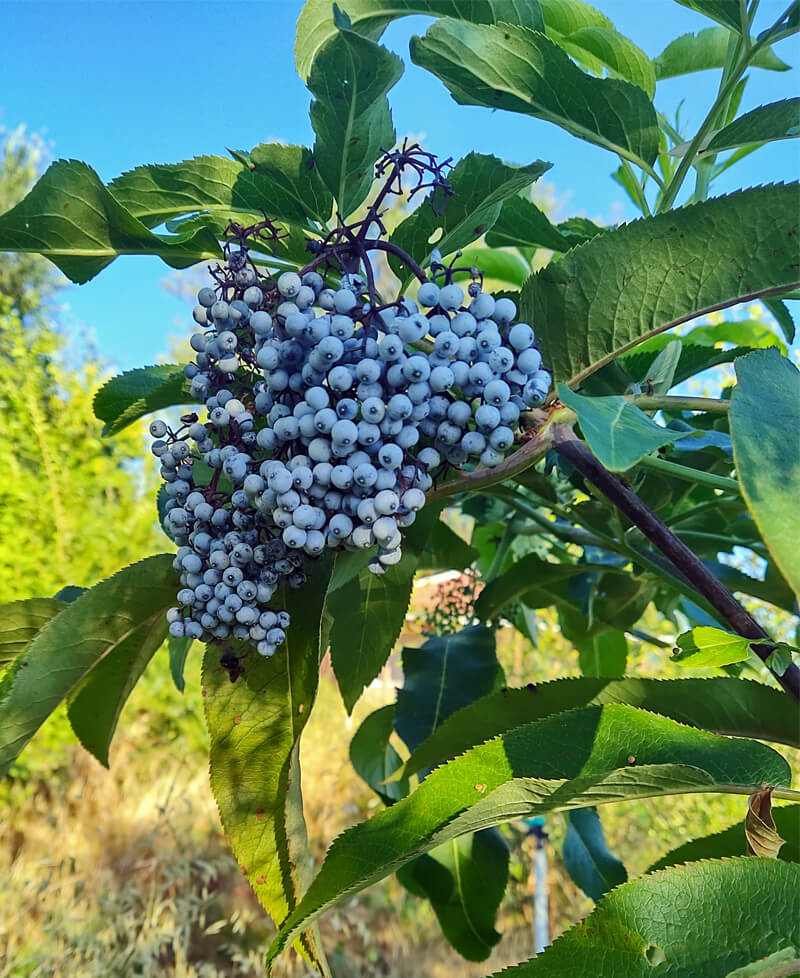
Sambucus caerulea - Western Blue Elderberry berries in late summer
Packing Plants For ShippingMost of our plants are shipped bare root while they are dormant from late November through April and ship via the U.S. Postal Service. Bamboo plants can be shipped in their containers year-round by UPS.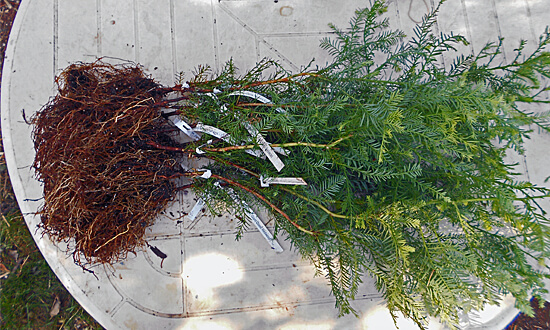 Bare root plants are soaked and wrapped together in bundles. ictured are 10x 24 inch tall Coast Redwoods. 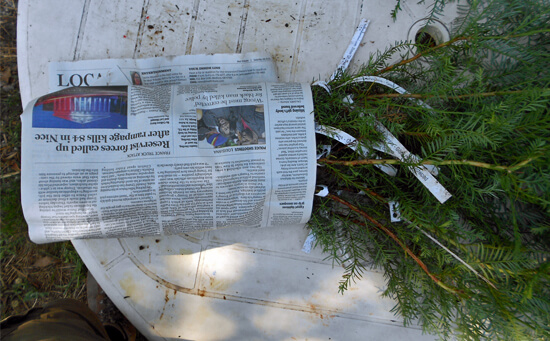 The bundled plants are wrapped in paper and labeled by variety. 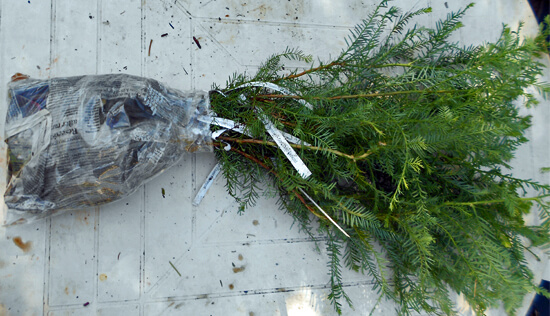 The bundle is wetted and bagged. 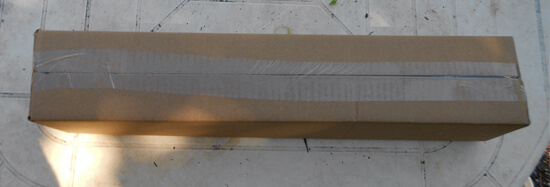 Bundles of plants are secured in long boxes. Pruning and Plant SizesWe prune both the tops and the roots of our plants at least once per year while they are growing in our nursery to ensure they develop a strong, dense form. Regular annual pruning goes a long way to ensure a healthy branching structure and this is often a missed step in many nurseries. Pruning a plant back hard after it has been neglected pruning-wise often results in an irregular branch habit or multiple leaders so we prune early and regularly instead. We also prune the roots of our plants while they are dormant which causes them to produce a much more branched structure and helps to elimate tangled masses that hinder future development. Plants that have been root pruned establish themselves much more quickly than root bound plants. Generally, hardwood plants will be pruned in the winter and conifers will be pruned in the summer.Before shipping plants we prune the tops and roots one last time. Conifers will usually have very little pruning except to balance out long branches. Shrubs are usually pruned to around 1-2 feet tall to encourage low branch development and small to medium sized trees are usually pruned to around 36-40 inches. Pruning trees at this height encourages dominant branches to begin forming around 3 feet from the ground which typically looks the best in most situations. However, if you want a tree to have branching start higher (some city codes require trees to not branch below 4 feet) we have longer boxes available. To request taller trees please contact us at least three days before your ship date. Depending on your location and the shipping routes there may be a fee for oversize package handling (usually about $15 for a 60 inch box). 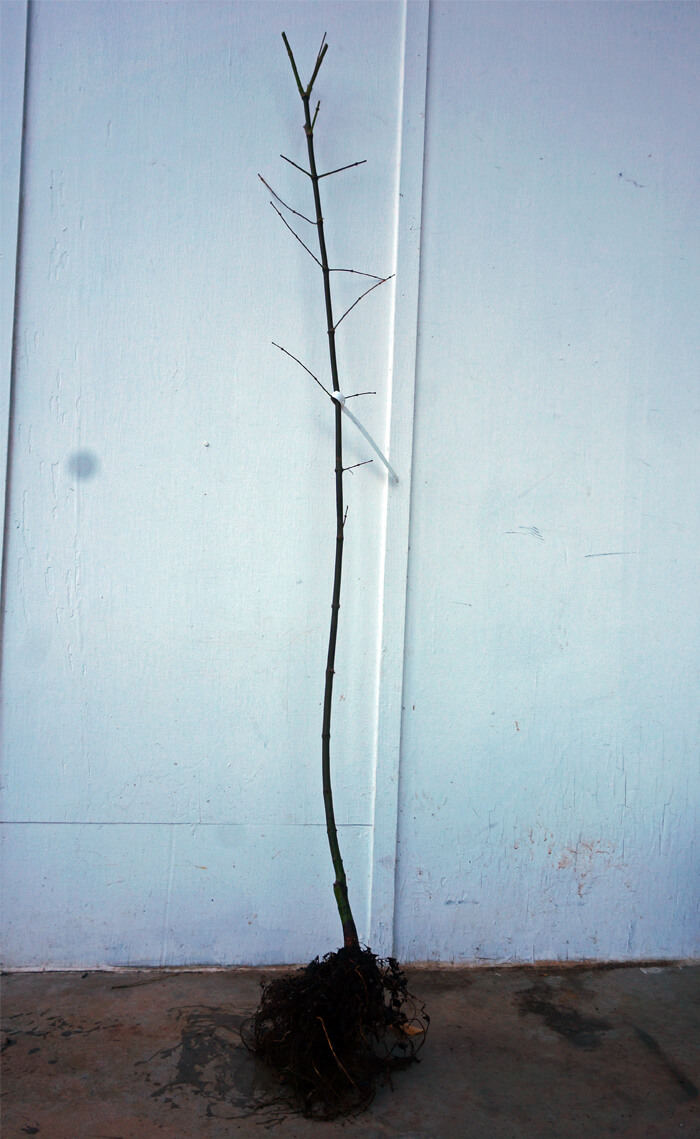 Tall trees (Oaks, Ginkgo, large Maples, etc.) are pruned to 40 inches to encourage crown development from about 36 inches and up 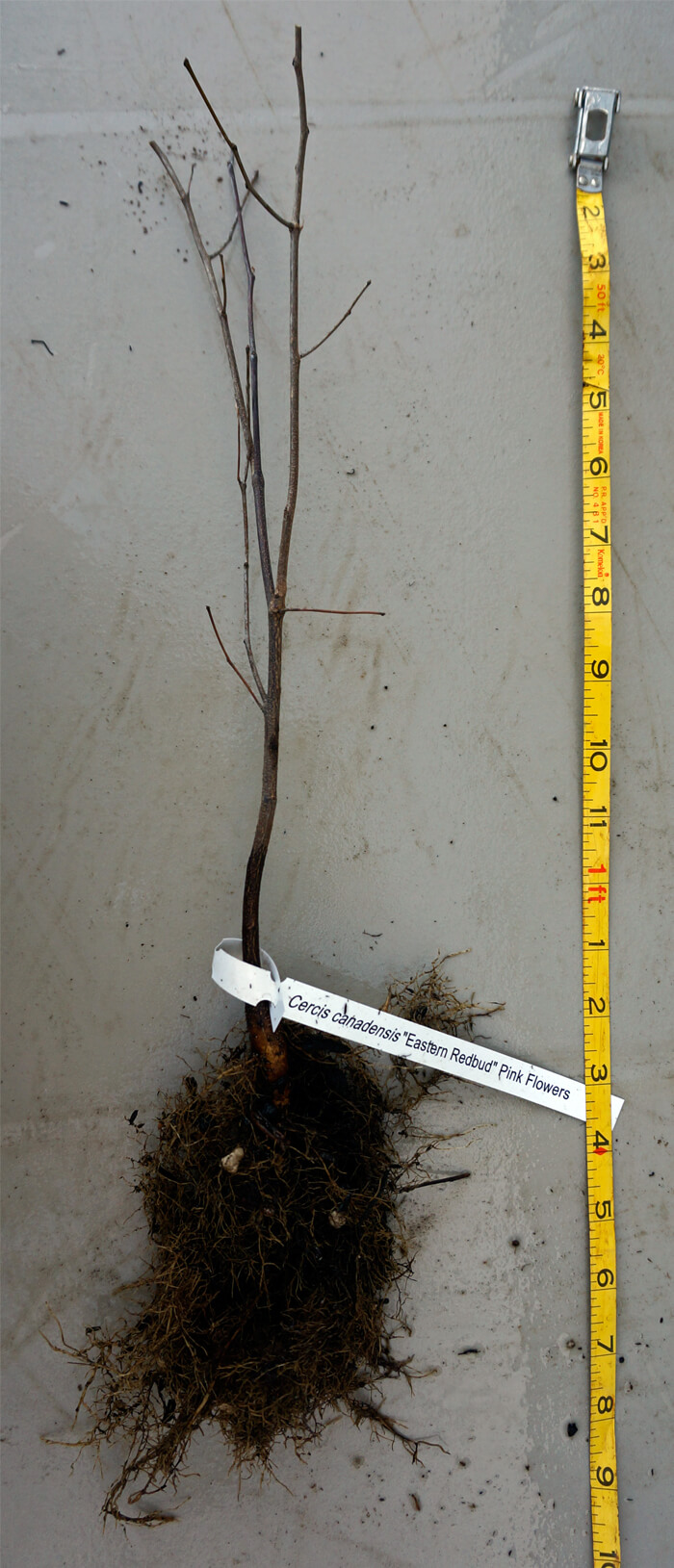 Small and medium trees (short Maples, Redbuds, Stewartia, etc.) are pruned 10-20 inches above the prune line from last year 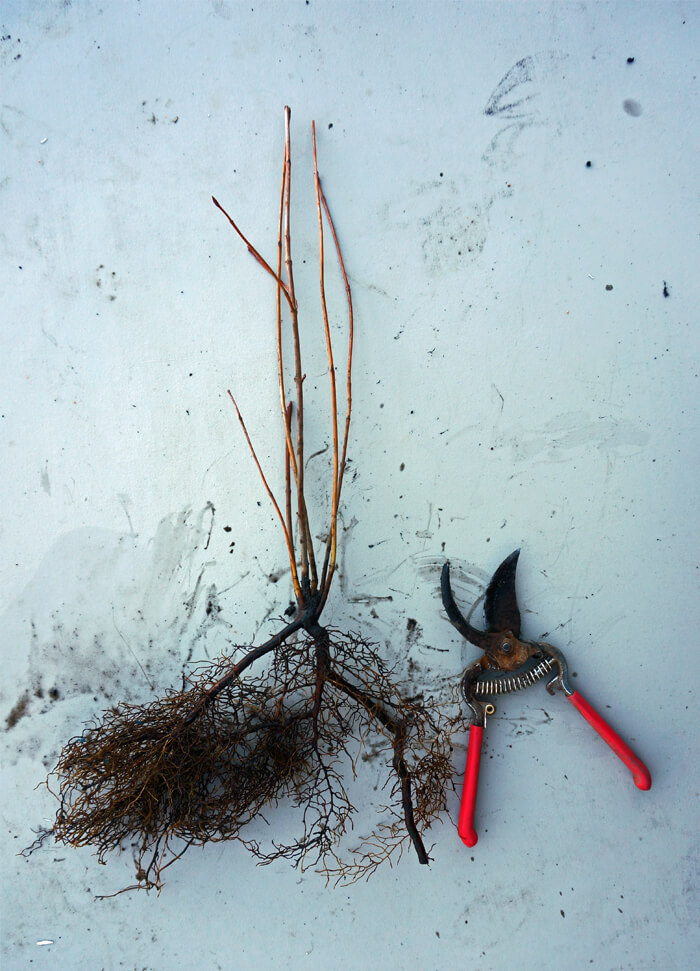 Shrubs (Weigela, Hydrangea, Viburnum, etc.) are pruned to 18 inches tall and root pruned one last time 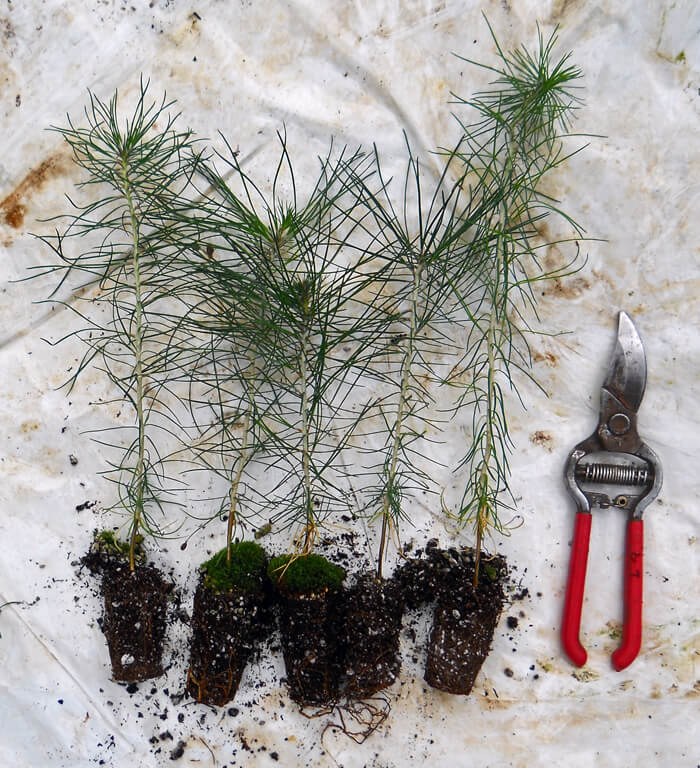 Small plug size Bamboo Plants Are Shipped In Their ContainersBamboo roots are not flexible and so plants have to be shipped in their containers. These plants are heavier and are shipped separately from bare root plants. Because they are potted they can handle longer transit times so can ship via UPS Ground instead of USPS Air Mail. Potted plants can also be shipped year-round.We regularly top our 1 gallon bamboo plants at 24-30 inches tall throughout the growing season. This results in dense, bushy foliage while allowing for economical shipping. From this size most running species will grow to 5-6 feet tall in the first spring and clumping species will usually grow to 4-5 feet tall. 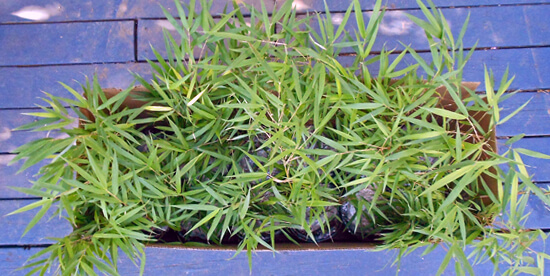 1 gallon bamboo plants strapped in and ready to be sealed. Unpacking Bare Root PlantsYou will be sent tracking details as soon as your plants are shipped. Unpack your plants as quickly as possible after they are delivered. We use two types of boxes, side-sealing and top-sealing. For boxes that are taped along the whole length you can cut the tape on either side and remove the plant bundles by cutting the tape holding the bundle to the bottom. For boxes that are sealed on the top and bottom, it is easiet to open the bottom of the box (the shipping label is at the top) and pull the bundle of plants out straight out. Check that the box is empty as there can be a second bundle of plants stuck towards the top.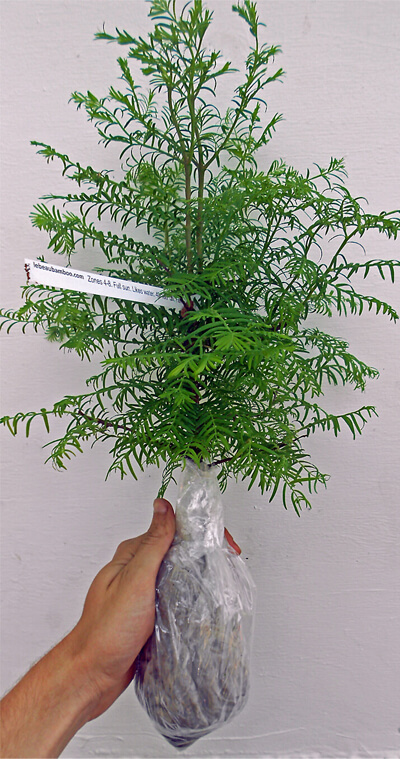 A bundle of trees. What if I am not able to plant right away?You can usually leave the plants in their shipping container unopened for 1-2 days if there were no shipping delays and you have received your plants from late November through February. Plants shipped when it is warmer can't stay in their packages for as long. |
Size Availability
crown - $8.50 each
Ships free with orders of $75!
Packed with a bagged root ball.
|


